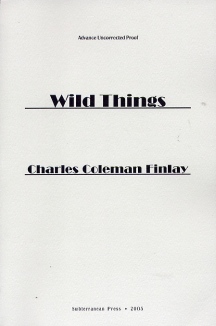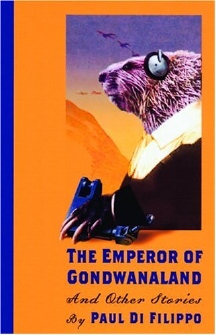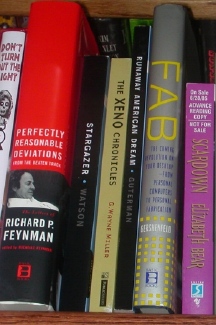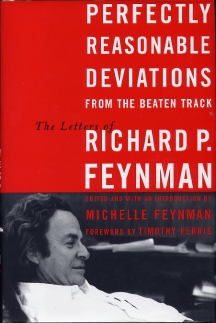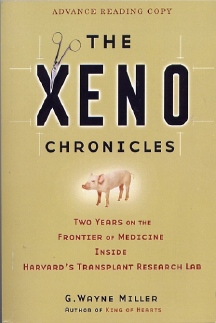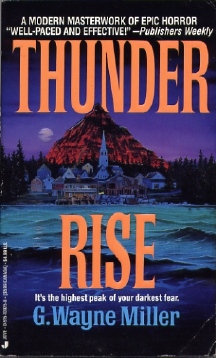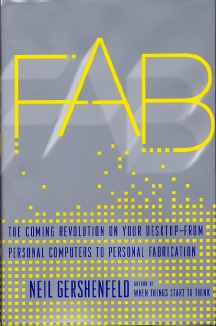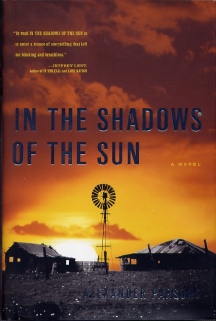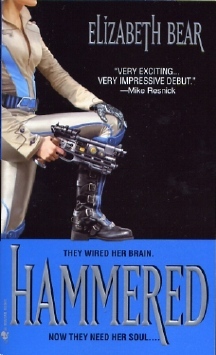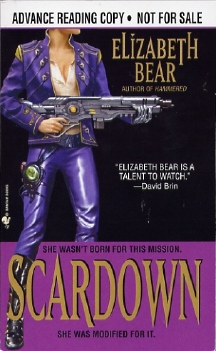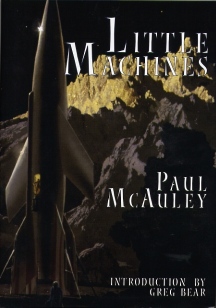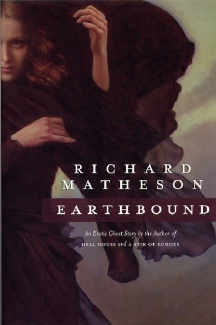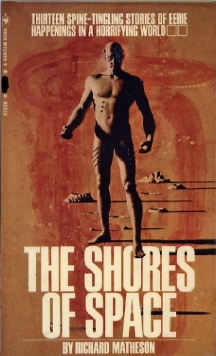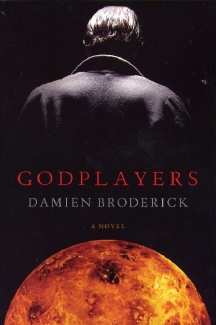|
|
|
This Just In...News from the Agony Column
|
04-15-05: Paul Di Filippo 'The Emperor of Gondwanaland' and Charles Coleman Finlay 'Wild Things' |
||||||
| The
Return of the Single Author Story Collection Well, I'm having a harder and harder time mourning the death of science fiction. One of the markers of science fiction's ill health has for me been the absence of the single author short story collection. Yes, Ace and Martin Greenburg have done a great job in keeping the market full of themed anthologies that feature many new names. This is a great service, the power of which cannot be underestimated. It helps authors get a foot in the door. But it does not help them get the rest of the way in. For that, they need to write and sell a novel, because a novel will appear on the shelves with their name on the spine. And a book with an author's name on the spine gets the author's name remembered. I find it interesting then, that in a field positively bursting with short fiction, we see so few single-author story collections. Yes, top names with novels can get it done, but there are a lot of writers out there who have only short fiction or primarily short fiction, or simply lots of short fiction. Publishers seem to have been reluctant to publish collections by a single author. Why? Well, presumably, they dont sell as well as novels. And because they dont sell, they aren't published and because they aren't published, they continue not to sell. Readers who might actually want to buy single-author story collections are forced to hope that a small press publisher will do so. But perhaps that's about to change. Especially when two delightful new single-author short story collections are headed our way in the coming months, one from a New York-based publisher and one from a prestigious small-press publisher. 'The Emperor of Gondwanaland' by Paul Di Filippo (Thunder's Mouth Press / Avalon Publishing ; June 10, 2005 ; $16.95) shows this courageous imprint from New York-based Avalon taking a big step to correct this problem. The forthcoming first collection from Charles Coleman Finlay, 'Wild Things' (Subterranean Press ; September 19, 2005 ; $25.00) is a fine example of the power of the small press to keep the single-author short fiction collection market alive. And both suggest that science fiction is on the upswing in the marketplace.
What 'Wild Things' offers in spades is variety. Hardish-SF, horror, alternate histories, experimental fiction, slipstream -- Finlay hits all the high notes. This is precisely the kind of author I tend to like; someone who simply writes without regard to outlet. 'Wild Things' has it all, and it's an excellent example of precisely why there should be more single-author story collections. In the right hands, they offer just as much variety as an anthology.
'The Emperor of Gondwanaland' offers 18 stories in six categories. The category names are worth recounting, though they're not stupendously informative as to the nature of the stories contained within. There's 'Periauricular Dampness' (rescued old stuff), 'Adventures of a Restless Mind' (omnibus within omnibus), 'Two Plus Two Equals Infinity' (collaborations), 'The Children of André Breton' (surrealism), 'Counterfactual Curiosities' (alternate histories) and the self-explanatory 'Gonzo Science'. As for the original appearances of these stories, the only repeat market here is Interzone. That's a pretty great sign. One of the pleasures often, though not always afforded by a short story collection, are the introductions. Many a writer has become famous for them, including superstars Harlan Ellison and Howard Waldrop. Di Filippo is set to join this elusive fraternity if what I read here is any example. And there are lots of examples, with an overall introduction, an introduction for each section and each story. Maybe it's just my ever-hopeful nature. Odd, that I of all people should end up being an enthusiastic optimist. I certainly never saw that coming. But frankly, it's all I can do to keep up with the books I get that look somewhere between good and great. And these two certainly seem on the high side of that estimation. Yes, the world is going to hell in a handbasket. But there are a lot of great books to keep your mind occupied on the way down. |
|
04-14-05: Publisher Spotlight on Basic Books; Richard P. Feynman 'Perfectly Reasonable Deviations from the Beaten Track', G. Wayne Miller 'The Xeno Chronicles', Neil Gershenfeld 'Fab' |
|||||||||||||||
Science
for Science Fiction Readers and Writers
This stack seems particularly interesting to science fiction readers and writers alike, as well as general interest readers just looking for a good if offbeat book. There's a bit of variety here that you might not expect from the world of non-fiction science. There's a tome perfect for the bed stand -- 'Perfectly Reasonable Deviations from the Beaten Track: The Letters of Richard P. Feynman'. Then there's the more novelistic book by one-time horror novelist G. Wayne Miller, 'The Xeno Chronicles'. And finally, we have the info-filled, pixilated world of 'Fab' by Neil Gershenfeld. Each of these books has plenty to offer readers, writers, those who are both, and those are currently readers but hoping to become writers. It would be my guess there are more would-be writers in the world of science fiction readers than there are in any other genre. For one reason, with great magazines like Interzone, F&SF, Asimov's and Argosy -- to name but a few -- there's a huge market for short fiction. And that market multiplies almost exponentially when you include high-flying websites like Strange Horizons, SciFiction, Fantastic Metropolis and Ideomancer, naming but a few here as well, and add in a slew of themed and non-themed anthologies coming out weekly. And the competition is still fierce. While the competition to sell short fiction is fierce the world round, in all genres and all markets, the SF world seems to breed a rather larger percentage of both markets and writers. So how to generate a decent story? Write a lot of course, write every day, of course. But more importantly, you need ideas. I remember back when I was a teenager and Harlan Ellison first published 'Alone Against Tomorrow'. In it, he actually gave out his phone number. Halcyon and innocent days, those were. When I first got the book, I took it over to a friend's house and decided to call the number on a dare. It rang, then someone picked up. "Hello, is this Harlan Ellison?" I asked. "Yeah," he answered, ever the gentlemen. Damn. I was kind of flummoxed. I didn't expect it to be at all this easy. What the hell was I supposed to say? "Hey, uh, where do you get your ideas?" "I don't know man, they just come to me." "Well, I really like your books." "Thanks." What else can I say? What else can I say? "Thanks....Uh bye." "Bye." And such was my one meeting with a science fiction great. The point being, to bring this back to reality, that were one to think about the question: "Where do science fiction writers get their ideas?" an obvious answer might be from duh -- science! But more importantly, these three books just look to me like good reading.
On one hand, you can read it from beginning to end, and enjoy the growth of Feynman's voice, the sweep of his ideas clattering across the years. But you can also keep it for bed stand reading, picking it up to read a few missives here and there, just to enjoy Feynman's thoughts. Included are letters both from and to Feynman, so you get a wider sense of the discussions, the conversations, the back-and-forths of the workings of a great mind. As for the science fiction writer, these letters offer a gold mine of voice -- the true voice of a true genius. Yes, there are plenty of other books by Feynman, but there's a big difference between what someone writes for publication and what someone writes to one's peers and friends. Were one to be creating the character of a scientist -- not an unusual task in science fiction -- then here we have a perfect example of the more everyday voice of a scientist and thinker. Alas, for writer Elizabeth Bear -- who re-creates Feynman himself as a rogue AI in her novels 'Hammered' and in the forthcoming 'Scardown' --perhaps this comes a bit too late. Still, she's probably got another pass at the final book in the trilogy, 'WorldWired', and for that book, this slab comes just in time. For the rest of us mortals, it's a strange, rare thing in close up. And frankly, at twenty-six bucks, with lots of photos, it's something of deal. How could you pass this by?
Nowadays, with human organ transplants commonplace, Sachs wants to be able to use animal parts to treat sick people, a process he calls xenotransplantation, or xeno for short. The potential is huge in many respects. There's the possibility that sick people could be cured, transplant waiting lists slashed, lives saved. The great human upside. Of course, there's also a pot of money to be made as well. Miller follows both trails. He was given "exclusive and unprecedented inside-the-lab access," as he followed Sachs and his team through their research, their experiments, their successes and failures. Apparently, the money types have been waiting on this for a while, longer, in fact, than they would prefer to wait. Time is running low, money is lower and encouraging results dont come until the end is in sight.
Miller should be a familiar name to The Agony Column's readers, those who have been with us since the very, very, very beginning. Miller started his career with a nice slab of early-nineties horror titled 'Thunder Rise'. It's an entertaining take on the town-under-supernatural-assault genre with a talking ramphorynchus, Indian gods and other assorted monsters. I'd actually wondered what had happened to this writer, as the novel was quite slick and well written, if a bit on the generic side. Still, the ability to write a fine, compelling page-turner speaks well to Miller's ability to create a page-turning work of non-fiction. And frankly, any book I read better make me turn the damn pages, as the alterative is book launching and flight. Miller's other work includes 'Toy Wars'. And that sounds science fictional on so many levels, its appeal requires no explanation. And for your infusion of big brains, you can ask for no more than Neil Gershenfeld's 'Fab' (Basic Books / Perseus Books ; April 30, 2005 ; $26.00). Here's a book for the Charles Stross / Cory Doctorow set, I would think, covering as it does the upcoming and still rather science-fictional sounding revolution in desktop fabrication. So yes, those cornucopias that Stross and Doctorow are always on about -- just around the corner.
As for 'Fab', it does look as if it will live up to its name, and certainly be far more everyman-readable than Gershenfeld's 'The Nature of Mathematical Modeling'. And for the many computer programmers in the crowd -- and especially those who aren't -- it's fascinating that throughout the book, Gershenfeld uses a "Hello World" programming model. Now, for those who aren't programmers, here's the story. In the very first book on C Programming, written back in 1978 by Brian Kernighan and Dennis Ritchie, the very first program you see and learn to compile, one that anyone can learn to write and compile, is a program that displays the text string "Hello World". Here it is: /* Hello World program */ #include<stdio.h> main() { printf("Hello World");} This program displays characters. Pretty easy and not real impressive, in a world where every day we see all sorts of complex moving graphics displayed. Back in 1978, it was pretty damn interesting, though -- which just shows you how fast the tech moves. What Gershenfeld does in 'Fab' is to show you programs that dont just display pre-formatted characters -- they move atoms and molecules to create characters. By my standards, that's hot stuff. And 'Fab' certainly has lots more where that came from. For readers who sort of want their minds blown, and for writers who want to get a launch point from whence they can extrapolate the next version of the cornucopia, the personal fabricator, 'Fab' would appear to be the leader. And any of these three books would appear to be fine books for reading on any level; as a reading spectator, looking for some facts to leaven the fiction, or as a writer, looking for some facts to bolster or even inspire the fiction. They also offer a variety of material, from personal insights into the mind of a scientist to a novelistic look at the life and science-fictional-seeming work of scientist to a more general look at a field that's already been fodder for plenty of science fiction. Where do you get your ideas? They just come to me, man. In books. |
|
04-13-05: Alexander Parsons Lives 'In the Shadows of the Sun'; Elizabeth Bear 'Scardown' |
||||||
From
Pearl Harbor to the Bomb
Soon after Pearl Harbor, the men of the 200th and 515th Coast Artillery Regiments -- mostly Hispanic and mostly from New Mexico -- were sent to the Philippine Islands and after a four month battle were ordered to surrender to the Japanese. They were held in captivity for three and half years, and of the 1,800 men deployed, fewer than half returned. At home, their families were being evicted from their land to make way for test of the nascent atomic bomb. Surely there's one hell of a novel in this history -- and Alexander Parsons is the first out of the gate with 'In the Shadows of the Sun'. The Stricklands have sent their son to Philippines, to the Bataan Death March, to the Japanese prison camps. Those who remain are offered an eviction notice from their struggling ranch. And thus does this great country reward those who live here, but aren't frickin' millionaires. Parsons was a finalist for the PEN West award for his first novel, 'Leaving Disneyland', so he's got the prose chops for this kind of novel. A glance at the first page will utterly assure you of that. Parsons writes with an intensity equal to that of the events he's describing, and with an eloquence that brings to mind Cormac McCarthy, whose 'Blood Meridian' is surely one of the great horror novels of our time. And the reason I bring up McCarthy and genre fiction is that 'In the Shadows of the Sun' would certainly have been a science fiction novel had it been written before World War Two. Citizens evacuated from their homes to test an unknown weapon of immense power. An apocalyptic conflict seen in close-up. The impact of science on our society, our lives. Dont think that historical fiction -- straight, based-on-fact historical fiction -- cannot also be quite powerful science fiction. Twist your brain around in that direction and it brings a new perspective both to the historical fiction you read and the science fiction you read. What science fiction books are we reading now that will seem, well, mainstream fiction some twenty, thirty, forty, fifty years down the line? What's being done, right now, that we dont know boo about, and wont find out about until past the midpoint of this new century? Where are we marching, at this moment, towards a future we cannot imagine? |
||||||
Off
of the Earth, Into the Fire
If you've not read 'Hammered' and dont want the story well, munged if not ruined, since the fun is always in the reading, then stop reading this article now. Stop! Go read the review of 'Hammered', or Botticelli, her short story on this site. They both rock, she rocks, and you probably don't want to know even the least bit about 'Scardown', because it follows hot on the heels of 'Hammered'. So everybody is still reading, correct? Whatever. Dont say you weren't warned. The last chapter of 'Hammered' is almost the first chapter of 'Scardown'. Earth, having been placed in that big ol' handbasket we can all see around us, has finally arrived at the destination we know we're all heading towards. Jenny Casey couldn't give a rat's ass. She's on a starship named the Montreal, fercrissakes. Not the Constitution, not the Enter-friggin'-Prize, not the George Washington. The Montreal. But much of the rest of the cast of 'Hammered' is down in the thick of it, and they could quite certainly give a good deal more than...Well, suffice it to say that if you thought this was going to be a space opera (and I sort of did) it's not.
What we have here, folks, is a classic middle-of-the-trilogy book. Rest assured the whole shebang is complete. To ease your fears, you're going to get a slab of the (and I quote here) "riveting conclusion", titled 'WorldWired' at the end of 'Scardown'. Having read 'Hammered', I'm confident that Bear can deliver both a satisfying novel and a satisfying series entry, which is quite tricky. That cover promises cleavage and guns folks, the basic ingredients of all science fiction, right? Forget what it promises, we all know Elizabeth Bear will deliver one hell of a lot more. And by the time I return from my third WorldCon, I -- and the folks smart enough to actually sell books instead of just buying them -- should have a few signed copies of this for you to buy and read. In the interim however, make sure you pop over to Bear's website and her utterly entertaining blog. And don't buy copies of this damn ARC on E-Bay! Look, if you want this author to write books, youre going to have to buy the ones she actually makes a few samolians from. I'm telling you, the only thing you should buy from E-Bay is a ghost-in-a-jar, or maybe some haunted boxers. In the event your own boxers aren't haunted. And if they are -- put them in a jar. Sell them on E-Bay. And don't expect me to buy them. My money is all being spent on books at various and lucky independant booksellers. |
|
04-12-05: Pam Lewis Warns 'Speak Softly, She Can Hear'; Paul McAuley's 'Little Machines' |
|||
Your
Friend's Enemy
So credit Simon and Schuster for getting 'Speak Softly, She Can Hear' by Pam Lewis (Simon and Schuster ; March 1, 2005 ; $23.00) into my hands on the strength of the cover design and title alone. Yes, I'm as shallow as can be, but the clear mylar cover with the title type over the four-color photo printed directly on the hardcovers is very eye-catching. The graphic itself -- footprints in the snow leading to a red splatter -- is just subtle enough to be intriguing without an ick factor. So it gets the book off the pile and into my hands. The DJ copy lets me know that this is the story of two female friends with a "stomach-turning" secret that is kept across lives and decades, from coast to coast. It seems to offer a bit of grue and a bit of lit, and the author has had short fiction published in The New Yorker. If we're talking about a purely literary novel, then the New Yorker credit might not have much heft. But this is a novel of suspense, and literary leanings lend such work more interest. Of course what makes me take it to the counter is a quick sampling of page 1 and page n where I find quiet, textured prose and a subtly disturbing undertone. In the end of course, the writer has to deliver the goods. But in different packaging, with different graphics, this might never have made that initial journey from the stacks to my hands. And the fact of the matter is that making it into Rick Kleffel's hands may not be a Good Thing for this novel. It's possible that the publisher wanted this novel to be picked up by an entirely different demographic -- someone younger, looking for straight-up literature, rather than someone older, looking for literature with a twist. Evidence -- not coincidentally in the form of a bloodstain --makes me think they're looking reach to the large crime fiction audience. In that they're likely to be successful. |
|||
Prose
Engines
But. Unless you are one of the names in that haiku above, then chances are you're not going to make enough money as a novelist to make ends meet either. Novelists who can make a living only from writing novels would probably flesh out a prose poem, 200 words or less. So you'll be working at Borders (like superstar Ramsey Campbell) or writing a lot of short stories. Or maybe AND writing short stories. But. But. Particularly in genre fiction and even more particularly in science fiction, the short story market is an economic evolutionary ecology. Survival of the fittest, and the hottest, while the rest gather about for table scraps. On one hand this is somewhat heartening for the unpublished writer; those stories are coming back because they actually do have better ones. And simultaneously disheartening because youre in competition with the folks whose novels you're reading when you're not writing. Solid advice: dont quit the day job. And yet as robust as the market for short fiction is, the market for single-author short story collections is well, much less than robust. Unless, of course, you're in that haiku or the prose-poem followup. All this goes to explain why PS Publishing and (thus far) not some major New York publisher brings us Paul McAuley's 'Little Machines' (PS Publishing ; June 1, 2005 ; £35.00/$50.00). And all that goes to explain that when you pick up this collection, you can expect no less than end-to-end excellence. Most noted for his far-flung space opera, the Confluence Sequence, and also well known for his here-and-now SF thrillers ('The Secret of the Life' and 'Whole Wide World'), McAuley here demonstrates that great virtue, versatility. Seventeen short stories, from 'All Tomorrow's Parties' ("A kind of pendant to the Confoluence trilogy", he tells us in the informative afterward) to 'A Very British History' (a very funny alternate history of the great British space program) to 'Cross Road Blues' (blues legend Robert Johnson at, well, you know, or should), 'Little Machines' offers a variety of prose engines to make your mind spin for the required span of time. Consider it night-stand reading for the big-brain set, the want-to-be-entertained set and the ever expanding Debt Set. I'm in the last category myself, especially after getting both the signed-by Paul-McAuley edition and the slipcased, signed-by-Paul-McAuley-and-Greg-Bear edition. It's true that money management is not my strong point, but if youre reading this column, it's probably not yours either. Unless your name is in that haiku, and then, wont you please write and send me a check? I've probably bought a large number of your books. But. But seriously. How can you resist a collection of stories by Paul McAuley especially in the oh-so-gorgeously-printed Chesley Bonestell wrap-around DJ. And, if you even know who Chesley Bonestell is, chances are you're not in that hot 18-35 demographic. So youd best snap up these copies, lest they go the way of the dodo and manned exploration of the moon. And my finances. |
|
04-11-05: David Francis Charts 'The Great Inland Sea'; Richard Matheson is 'Earthbound'; Damien Broderick Joins 'Godplayers'; Stephan Zielinski Interview |
||||||
Sunburn Country
The story is fairly straightforward. Life in New South Wales in the 1930's creeps forth in its petty pace from day to day, towards dusty death. As a young man Day witnesses his mother's death and leaves the family farm to become the caretaker for a horse named Unusual. He follows the horse to America, where he falls for Callie, who wants to become the first licensed woman jockey. Their self-immolating love leads him back home to face an even fiercer fire. So sure, you've got all the angst you can handle. Tragic loss, self-discovery, and horses. And from the outside, it sounds pretty intriguing. Then you open the book and read the chilled, dry prose that paints this portrait and find a rather different novel than you might have been expecting. "My father called me The Creeping Jesus. After seeing him with Leonie on the bed above me, I scraped through a space between fallen boards in the corner of the hut. He didn't see me leave." And you realize what you have here is a mystery with all the genre affectations scraped away, a literary novel scrubbed clean of literature. Moreover, there's a sense of humor at work here as well, as dry as the Australian outback. "Whenever I see a telephone in a rich person's house, I want to sneak a phone call to somewhere far away." And picking up the book on the shelves, the more you flip through it, the more you'll find great writing. Every page has something to grab the reader, hold you close and not let you go. When I see a novel that has that sort of meaningful, literary look to it, I tend not to trust it. I want to read something that's good, not good for me. Francis has this inclination as well, and it suggests that 'Great Inland Sea' might just be a great, enjoyable novel. "'I'd rather be loved than trusted,' I say." |
||||||
In the Past, Beyond the Grave
'Earthbound' is the resurrection of a short novel first published some 23 years ago under the pseudonym of "Logan Swanson". One can only wonder at Matheson's state back then. In the future he'd written about so often and so eloquently, he would be designated a literary treasure. The stories I read behind my parents' couch touched three generations as produced by Rod Serling's 'Twilight Zone'. But in 1982, Matheson, watching horror authors pop into being around him, might well have been in a very dark place. His fiction, as usual, was certainly in a dark place.
I'm a bit surprised that Tor didn't make this title part of its new "Paranormal Romance" imprint, because we're now being besieged by a wave of books that use Matheson's tempestuous template as a launch point for a whole new generation of hubba-hubba literature. We're fortunate to have this is a very nice trade paperback format with a great cover illustration by Michael Deas. It's simple but alluring, like Matheson's fiction. This trade paperback could easily have been one of those little thorn-like surprises that one encounters in imprints like Tor's Paranormal Romance series. But I'm also quite glad it's been given the quality treatment, because there's a lot in the Matheson that gets left behind in the sudsy romances. Like grit, tension, true, gut-clenching terror. I'll never forget those forbidden moments behind the couch. And I'll spend the rest of my life trying to resurrect them. |
||||||
Omnipotence Seen as a Video Game
But I can definitely take literature about games seriously, especially when it's Damien Broderick's 'Godplayers' (Thunder's Mouth Press / Avalon Books ; May 3, 2005 ; $14.95). If youre looking for that sort of Agony Column obscure SF pick-of-the-week, here it is. You've got your slightly obscure Australian (in this case) novelist who has a rather large back catalogue, including a five novel series about the 'Faustus Hexagram', with novels stretching back to his 1970 work 'Sorcerer's World'. You've got a novel with a blurb from Charlie Stross and comparisons to classic science fiction writers including Zelazny and Van Vogt. It's interesting that Van Vogt has come back round into vogue, as it was my impression that he'd been cast out as No Longer Applicable in this new age of Bright Young Things. But looking at Broderick's history, be clear that you dont have a twenty-something author mirroring the twenty-something protagonist. You've got a seasoned vet who is kicking ass and taking no prisoners. That twenty-something protagonist is August Seebeck, who is having problems dealing with his great-aunt's claim that corpses appear in her bath Saturday night only to disappear the next morning. August isnt buying it, until he sees it happen. Even then, he's nonplussed, at least until someone steps out of the mirror. Then like any great SF protagonist, he finds that he's part of the Big Secret That Controls The World. And in this case, not just this world, but the many worlds of the multiverse. Yes, that damn multiverse is coming round to bite you about once a month, so you might as well get bit by someone who's been round the damn thing a few times. Especially since this multiverse is computational. You know the old saw -- from back in Twilight Zone or Outer Limits times -- about how our world, our universe is just a big ol' game simulation for bored deities? Well, Broderick plays that through a heavy-duty computational quantum physics filter, with a big dose of video games -- and out comes 'Godplayers'. And then some. Trade paperback original and nice slick cover design say it's a Philip K. Dick Award nominee to me. How about you? Are you secretly omnipotent? You might be. Check your great-aunt's bathtub on a Saturday night. Make sure youre armed with a taser, and don't turn your back on any mirrors. |
||||||
Hard
Boiled MONSTERS!
First and foremost, let me take a moment to remind the readers that my interviews are possible largely because of the kindness of KUSP. Should you feel the need to make a gesture of thanks to this column, the best way to do so would be to pledge to KUSP and mention my name. That will get us yards and yards more slack to interview writers both well known and brand-new. I dont ask for anything really -- I'm just here to help connect readers and books -- but this is the one way you can help keep this concern going. But back to Stephan (say it correctly!) Zielinski. We were so busy talking about the San Diego Zombie and his hard-boiled fiction that we never got to how he sold the book until afterwards, at a nearby coffee shop. There he told me he sent in the first fifty pages and a summary to Tor books. It sat in the slushpile until Teresa Nielsen-Hayden, read, loved it and asked for more, which he naturally sent. Without contact info on each page. Oops! Eventually, Ms. Hayden managed to get the information, and practically a generation later, out comes this delightful novel of very strange goings-on in San Francisco. Zielinski is an absolute hoot, and I know you'll enjoy this even as you feel it suck the money for the hardcover out of your pocket. I mean, how can you resist a man who manages to find an opportunity to shout during an interview: "MONSTER!" Did you miss that? I'm sorry. "MONSTER!" |
